历史
Founding of Brown
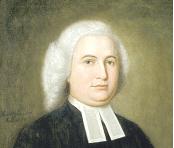
First Brown President and Delegate to the Congress of the Confederation James Manning. Detail from an oil painting by Cosmo Alexander, 1770; in University Hall, Brown University, Providence, R.I.
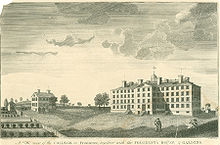
This copper-plate engraving from 1795 is the first known image of Brown. The original campus was a single academic building that was later named University Hall.
In 1763, The Reverend James Manning, a Baptist minister and an alumnus of the College of New Jersey (predecessor to today's Princeton University), was sent to Rhode Island by the Philadelphia Association of Baptist Churches in order to found a college. At the same time, local Congregationalists, led by future Yale College president Ezra Stiles, were working toward a similar end. The inaugural board meeting of the Corporation of the College in the English Colony of Rhode Island & Providence Plantations was held in the Old Colony House in Newport, Rhode Island. Former Royal Governors of Rhode Island under King George III Stephen Hopkins and Samuel Ward were among those who played an instrumental role in Brown's foundation and later became American revolutionaries. On March 3, 1764, a charter was filed to create the College in Warren, Rhode Island, reflecting the work of both Stiles and Manning. The university charter was executed under the authority of King George III.
The charter had more than sixty signatories, including the brothers John, Nicholas and Moses of the Brown family, who would later inspire the College's modern name following a gift bestowed by Nicholas Brown, Jr.. The college's mission, the charter stated, was to prepare students "for discharging the Offices of Life with usefulness & reputation" by providing instruction "in the Vernacular and Learned Languages, and in the liberal Arts and Sciences." The charter's language has long been interpreted by the university as discouraging the founding of a business school or law school. Brown continues to be one of only two Ivy League colleges with neither a business school nor a law school (the other being Princeton).
The charter required that the makeup of the board of thirty-six trustees include twenty-two Baptists, five Friends, four Congregationalists, and five Church of England members, and by twelve Fellows, of whom eight, including the President, should be Baptists "and the rest indifferently of any or all denominations." It specified that "into this liberal and catholic institution shall never be admitted any religious tests, but on the contrary, all the members hereof shall forever enjoy full, free, absolute, and uninterrupted liberty of conscience." One of the Baptist founders, John Gano, had also been the founding minister of the First Baptist Church in the City of New York. The Encyclopedia Britannica Eleventh Edition remarks that "At the time it was framed the charter was considered extraordinarily liberal" and that "the government has always been largely non-sectarian in spirit."
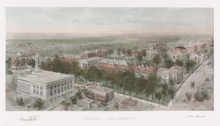
Watercolor painting by Richard Rummell from that depicts an aerial view of campus in 1908. Although the John Hay Library had not yet been built, the design had been approved so the artist included it.
James Manning was sworn in as the College's first president in 1765. His tenure ended in 1791. The College in the English Colony of Rhode Island and Providence Plantations moved to its present location on College Hill in the East Side of Providence in 1770 and construction of the first building, the College Edifice, began. This building was renamed University Hall in 1823.
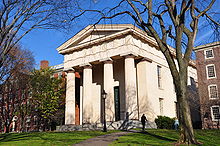
Hope College (left) was built in 1822, while Manning Hall (right) was built in 1834.
The Brown family — Nicholas, John, Joseph and Moses — were instrumental in the move to Providence, funding and organizing much of the construction of the new buildings. The family's connection with the college was strong: Joseph Brown became a professor of Physics at the University, and John Brown served as treasurer from 1775 to 1796. In 1804, a year after John Brown's death, the University was renamed Brown University in honor of John's nephew, Nicholas Brown, Jr., who was a member of the class of 1786 and in 1804 contributed $5,000 toward an endowed professorship. In 1904, the John Carter Brown Library was opened as a research center on Americas based on the libraries of John Carter Brown and his son John Nicholas Brown.
The Brown family was involved in various business ventures in Rhode Island, and made a small part of its wealth in businesses related to the slave trade. The family itself was divided on the issue. John Brown had unapologetically defended slavery, while Moses Brown and Nicholas Brown Jr. were fervent abolitionists. In recognition of this complex history, under President Ruth Simmons, the University established the University Steering Committee on Slavery and Justice in 2003.
Brown began to admit women when it established a Women's College in Brown University in 1891, which was later named Pembroke College in Brown University. "The College" (the undergraduate school) merged with Pembroke College in 1971 and became co-educational.
Several of the original organizers and founding trustees and fellows of Brown listed in the section concerning the formation of Brown's founding charter were prominent business figures, religious figures or statesmen in the original thirteen colonies or in Rhode Island, particularly during the American Revolutionary period. Their individual lives reflect the historical currents that prevailed during a period of historic transition for the American colonies and for the rise of democratic governance as the colonies moved from legal integration within the British Empire to full fledged American independence. The original Brown University Charter (including its signatories and advocates) is a document of significant historic interest and offers a glimpse into this momentous historical period.
Petitioners for the Creation of Brown University
At the General Assembly of the Governor and Company of the English Colony of Rhode Island and Providence Plantations, in New England, in America, begun and holden by adjournment at East Greenwich, within and for the Colony aforesaid, on the last Monday in February, in the year of our Lord One Thousand Seven Hundred and Sixty-four, and fourth of the reign of His Most Sacred Majesty George the Third, by the Grace of God, King of Great Britain, and so forth. AN ACT FOR THE ESTABLISHMENT OF A COLLEGE OR UNIVERSITY WITHIN THIS COLONY
"Petitioners" and "undertakers in the valuable design ... to found, endow, order, and govern a College or University within this Colony":
Daniel Jenckes, Esq., Nicholas Tillinghast, Esq., Nicholas Gardiner, Esq., Col. Josias Lyndon, Col. Elisha Reynolds, Peleg Thurston, Esq., Simon Pease, Esq., John Tillinghast, Esq., George Hazard, Esq., Col. Job Bennet, Nicholas Easton, Esq., Arthur Fenner, Esq., Mr. Ezekiel Gardner, Mr. John Waterman, Mr. James Barker, Jr., Mr. John Holmes, Solomon Drown, Esq., Mr. Samuel Winsor, Mr. Joseph Sheldon, Charles Rhodes, Esq., Mr. Nicholas Brown, Col. Barzillai Richmond, Mr. John Brown, Mr. Gideon Hoxsey, Mr. Thomas Eyres, Mr. Thomas Potter, Jr., Mr. Peleg Barker, Mr. Edward Thurston, Mr. William Redwood, Joseph Clarke, Esq., Mr. John G. Wanton, and Mr. Thomas Robinson,
Founding Fellows and Trustees of Brown University

Stephen Hopkins with Brown University in the background
"... known in law by the name of Trustees and Fellows of the College or University in the English Colony of Rhode Island and Providence Plantations, in New England, in America...":
Hon. Stephen Hopkins, Esq., The Hon. Joseph Wanton, Jr., Esq., The Hon. Samuel Ward, Esq., The Hon. William Ellery, Esq., John Tillinghast, Esq., Simon Pease, Esq., James Honyman, Esq., Nicholas Easton, Esq., Nicholas Tillinghast, Esq., Darius Sessions, Esq., Joseph Harris, Esq., Francis Willet, Esq., William Logan, Esq., Daniel Jenckes, Esq., George Hazard, Esq., Nicholas Brown, Esq., Jeremiah Niles, Esq., Joshua Babcock, Esq., Mr. John G. Wanton, The Rev. Edward Upham, The Rev. Jeremiah Condy, The Rev. Marmaduke Brown, The Rev. Gardner Thurston, The Rev. Ezra Stiles, The Rev. John Greaves, The Rev. John Maxson, The Rev. Samuel Winsor, The Rev. John Gano, The Rev. Morgan Edwards, The Rev. Isaac Eaton The Rev. Samuel Stillman, The Rev. Samuel Jones, The Rev. James Manning, The Rev. Russel Mason, Col. Elisha Reynolds, Col. Josias Lyndon, Col. Job Bennet, Mr. Ephraim Bowen, Joshua Clarke, Esq., Capt. Jonathan Slade, John Taylor, Esq., Mr. Robert Strettle Jones, Azariah Dunham, Esq., Mr. Edward Thurston, Jr., Mr. Thomas Eyres, Mr. Thomas Haszard, Mr. Peleg Barker,
And it is further enacted and ordained by the authority aforesaid that each Trustee and Fellow, as well those nominated in this Charter as all that shall hereafter be duly elected, shall, previous to their acting in a corporate capacity, take the engagement of allegiance prescribed by the law of this Colony to His Majesty King George the Third, his heirs and rightful successors to the crown of Great Britain, which engagement shall be administered to the present Trustees and Fellows by the Governor or Deputy Governor of this Colony, ....
At the annual meeting of the corporation on September 4, 1782, the first after the French troops evacuated the college edifice, the chancellor “moved that the college Charter be read. And it thereby appearing... that in consequence of the American Revolution, many things therein were evidently inconsistent with our present state of National Independence,” a committee of three was elected “to revise the same.” Later in the day the committee presented a new engagement which omitted the oath of allegiance to King George: “You [name of individual] being elected a [Trustee or Fellow] of the College or University in the State of Rhode Island and Providence Plantations, do solemnly engage, that you will faithfully execute the said office, agreeably to the Charter of the said College or University, to the best of your Judgment or ability.” The committee also expressed the opinion that the Corporation should “report the necessity of this alteration to the General Assembly, & request their approbation of the measure; & their establishment in future of the present form, or such other as they shall think fit to substitute.”
Source: Brown University Charter
See also: Walter C. Bronson’s The History of Brown University (Providence, 1914).
American Revolution
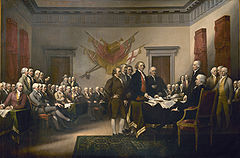
John Trumbull's
Declaration of Independence. The signers included Brown's first chancellor Stephen Hopkins. Hopkins wears a hat and stands in the back of the room near the door on the left.
Stephen Hopkins, Chief Justice and Royal Governor of the English Colony of Rhode Island and Providence Plantations, was later a Delegate to the Colonial Congress in Albany in 1754 and to the Continental Congress from 1774 to 1776. He was a signatory to the United States Declaration of Independence on behalf of the state of Rhode Island. He also served as the first chancellor of Brown (at the time called the College in the English Colony of Rhode Island and Providence Plantations) from 1764 to 1785. His house is a minor historical site, located just off the main green at Brown. At the time of his signature of the Declaration of Independence, Stephen Hopkins served as Chief Justice of Rhode Island and Chancellor of Brown.
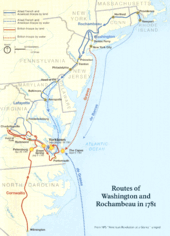
National Park Service map of the W3R Route
In 1781, allied American and French armies under the command of General George Washington and the Comte de Rochambeau, who led troops sent by King Louis XVI of France, embarked on a 600-mile (970 km) march from Rhode Island to Virginia, where they fought and defeated British forces sent by King George III of the United Kingdom on the Yorktown, Virginia peninsula. The victory ended the major battles of the American Revolutionary War. Prior to the march, Brown University served as an encampment site for French troops, and the College Edifice, now University Hall, was turned into a military hospital.
Other founders of Brown who played significant roles in the American revolutionary effort included John Brown in the Gaspee Affair, Chief Justice Dr. Joshua Babcock as major general in the state militia and William Ellery as a signatory to the Declaration of Independence. James Mitchell Varnum, who graduated with honors in Brown's first graduating class of 1769, served as one of General George Washington's Continental Army Brigadier Generals and later as Major General in command of the entire Rhode Island militia.[1]
In 1786, President James Manning served as a delegate for Rhode Island to the Continental Congress.
New curriculum
In 1850, Brown President Francis Wayland wrote: "The various courses should be so arranged that, insofar as practicable, every student might study what he chose, all that he chose, and nothing but what he chose." The adoption of the New Curriculum in 1969, marking a major change in University's institutional history, was a significant step towards realizing President Wayland's vision. The curriculum was the result of a paper written by Ira Magaziner and Elliot Maxwell entitled "Draft of a Working Paper for Education at Brown University." The paper came out of a year-long Group Independent Study Project (GISP) involving 80 students and 15 professors. The group was inspired by student-initiated experimental schools, especially San Francisco State College, and sought ways to improve education for students at Brown. The philosophy they formed sought to "put students at the center of their education" and to "teach students how to think rather than just teaching facts."
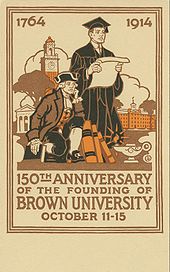
Poster celebrating Brown's 150 year anniversary in 1914
The paper made a number of suggestions for improving education at Brown, including a new kind of interdisciplinary freshman course that would introduce new modes of inquiry and bring faculty from different fields together. Their goal was to transform the survey course, which traditionally sought to cover a large amount of basic material, into specialized courses that would introduce the important modes of inquiry used in different disciplines.
Following a student rally in support of reform, President Ray Heffner appointed the Special Committee on Curricular Philosophy with the task of developing specific reforms. These reforms, known as the Maeder Report (after the chair of the committee), were then brought to the faculty for a vote. On May 7, 1969, following a marathon meeting with 260 professors present, the New Curriculum was passed. Its key features included the following:
- Modes of Thought courses aimed at first-year students
- Interdisciplinary University courses
- Students could elect to take any course Satisfactory/No Credit
- Distribution requirements were dropped
- The University simplified grades to ABC/No Credit, eliminating pluses, minuses and D's. Furthermore, "No Credit" would not appear on external transcripts.
Except for the Modes of Thought courses, a key component of the reforms which have been discontinued, these elements of the New Curriculum are still in place.
Additionally, due to the school's proximity and close partnership with the Rhode Island School of Design (RISD), Brown students have the opportunity to take up to four courses at RISD and have the credit count towards a Brown degree. Likewise, RISD students can also take courses at Brown. Since the two campuses are effectively adjacent to each other, the two institutions often partner to provide both student bodies with services (such as the local Brown/RISD after-hours and downtown transportation shuttles). In July 2007 the two institutions announced the formation of the Brown/RISD Dual Degree Program, which allowed students to pursue an A.B. degree at Brown and a B.F.A. degree at RISD simultaneously, taking five years to complete this course of study. The first students in the new program matriculated in 2008.
As recently as 2006, there has been some debate on reintroducing plus/minus grading to the curriculum. Advocates argue that adding pluses and minuses would reduce grade inflation and allow professors to give more specific grades, while critics say that this plan would have no effect on grade inflation while increasing unnecessary competition among students and violating the principle of the New Curriculum. Ultimately, the addition of pluses and minuses to the grading system was voted down by the College Curriculum Council.
The University is currently in the process of broadening and expanding its curricular offerings as part of the "Plan for Academic Enrichment." The number of faculty has been greatly expanded. Seminars aimed at freshmen have begun to be offered widely by most departments.
As a part of the re-accreditation process, Brown University is undergoing an expansive reevaluation of its undergraduate education offerings through the newly appointed Task Force on Undergraduate Education. This Task Force is charged with assessing the areas of general education, concentrations, advising, and pedagogy and assessment.
Brown, the Ivy League and slavery
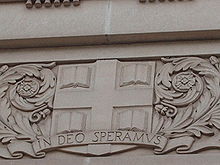
Brown University seal as a detail on a university building
In 2003, 18th Brown University President Ruth J. Simmons appointed the Steering Committee on Slavery and Justice, which included Brown faculty members, undergraduate and graduate students and University administrators. This Brown Steering Committee produced the first officially endorsed Ivy League report regarding the pre-Revolutionary commercial ties between the origins of one of the Ivy League institutions and the Triangular Trade in slaves taken from various regions in Africa. The Report of the Brown University Steering Committee on Slavery and Justice is a historic first for the Ivy League, which comprises a few member universities whose officially unexamined initial financial endowments were financed in some measure by wealth accumulated through the Triangular Trade, e.g. benefactor for Yale University Philip Livingston the elder, Yale College alumnus and promoter of then King's College (the former name for Columbia University) Philip Livingston the younger, and benefactor for Harvard University Isaac Royall, Jr. The carefully researched report offers several recommendations for Brown which are addressed in the official University response.
The Report of the Brown University Steering Committee on Slavery and Justice also offers a wealth of historical records and teaching materials available to the public worldwide regarding an important period in the history of the Ivy League, pre-Revolutionary New England and Triangular Trade contributions to the ascendance of Great Britain's leading universities, including the University of Oxford, University of Bristol and the University of Cambridge, prior to the Slave Trade Act of 1807 passed by the British Parliament. This act of Parliament outlawed the use of British ships in any aspect of the slave trade, in large measure as a consequence of the legislative leadership of Cambridge University alumni William Wilberforce and Prime Minister William Pitt the Younger. Wilberforce's work on slavery and justice was depicted in the film Amazing Grace. St. John's College, Cambridge has received funding to conduct inquiries similar to those led by the Brown Steering Committee on Slavery and Justice, but naturally focused on the benefits flowing from the Trianglular Trade which accrued to the British Empire and the United Kingdom's most prestigious institutions of learning, including those of Oxbridge. (The endowments bequeathed by Christopher Codrington to create Codrington Library at All Souls College, Oxford are one example of the benefits that flowed from the Triangular Trade involving Rhode Island.) As part of the commemoration of the Bicentenary of the Act of 1807 at Cambridge, President Simmons gave a public lecture at St. John's College entitled Hidden in Plain Sight: Slavery and Justice in Rhode Island.
The records are maintained by the Center for Digital Initiatives at Brown.
As one feature of the official February 2007 Response of Brown University to the Report of the Steering Committee on Slavery and Justice, President Simmons announced Brown's decision to create a U.S.$10 million endowment (£5,043,100.00; €7,400,000.00; ¥1,192,950,000.00) intended to benefit public schools in Providence, Rhode Island in part by funding graduate fellowships in urban education. This initiative echoes recommendations of former Brown president Vartan Gregorian, who suggested in several public addresses that the best remedy for the United States in its efforts to address the legacies of slavery and racial discrimination was to redouble commitments to K-12 education nationally. In that spirit, Dr. Simmons noted: "Lack of access to a good education, particularly for urban schoolchildren, is one of the most pervasive and pernicious social problems of our time. Colleges and universities are uniquely able to improve the quality of urban schools. Brown is committed to undertaking that work."
Brown's response to the Report of the Steering Committee on Slavery and Justice was published in the year marking the 200th anniversary of the abolition of the slave trade by the British Empire in the reign of King George III following a lengthy campaign by the Committee for the Abolition of the Slave Trade and the successor Society for the Abolition of the Slave Trade, as reported by the Oxford Today magazine and presented at Rhodes House in Oxford.
Presidents of Brown University
Main article: Presidents of Brown University

18th Brown President Ruth J. Simmons, 2001 - present.

Second Brown President Jonathan Maxcy, 1792–1802, and a member of the Class of 1787.
The current president of the University is Ruth J. Simmons. She is the 18th president of Brown University and first African American president of an Ivy League institution. According to a November 2007 poll by the Brown Daily Herald, Simmons enjoys a more than 80% approval rating among Brown undergraduates.
学术

Robinson Hall, now home to the Department of Economics, was the main university library in the 1800s.
The College
Main article: The College of Brown University
Founded in 1764, The College is the oldest school of Brown University. Nearly 6,000 undergraduate students are currently enrolled in the university, and approximately 80 concentrations are offered. The most popular concentrations are Biology, History, and International Relations. Brown is one of the few schools in the United States with a major in Egyptology available. Undergraduates can also design an independent concentration if the existing standard programs do not fit their interests.
Graduate School
Main article: Brown University Graduate School
建立于 in 1887, The Graduate School currently houses over 1,700 students studying over 50 disciplines. Eight different master's degrees are offered as well as Ph.D. degrees in over 40 subjects ranging from Applied Mathematics to Public Policy.
Alpert Medical School
Main article: Alpert Medical School
The University's medical program started in 1811, but the school was suspended by President Wayland in 1827 after the program's faculty declined to live on campus (a new requirement under Wayland). In 1975, the first M.D. degrees from the new Program in Medicine were awarded to a graduating class of 58 students. In 1991, the school was officially renamed the Brown University School of Medicine, then renamed once more to Brown Medical School in October 2000. In January 2007, self-made entrepreneur Warren Alpert donated $100 million to Brown Medical School on behalf of the Warren Alpert Foundation, tying Sidney Frank for the largest single monetary contribution ever made to the University. In recognition of the gift, the faculty of Brown University approved changing the name of the Brown Medical School to The Warren Alpert Medical School of Brown University. It is currently ranked 31st among U.S. medical schools in research and 23rd in primary care according to US News and World Report. Admissions to Alpert is one of the most competitive in the nation, with only less than 2% of those applying through the Standard Route accepted in 2008 (5,902 applications for 94 spots).
The medical school is known for its eight-year Program in Liberal Medical Education (PLME), which was started in 1984 and is one of the most selective programs in the nation. Each year, approximately 60 high school students matriculate into the PLME out of an applicant pool of about 1,600. Since 1976, the Early Identification Program (EIP) has encouraged Rhode Island residents to pursue careers in medicine by recruiting sophomores from Providence College, Rhode Island College, the University of Rhode Island, and Tougaloo College. In 2004, the school once again began to accept applications from premedical students at other colleges and universities via AMCAS like most other medical schools. The medical school also offers combined degree programs leading to the M.D./Ph.D., M.D./M.P.H. and M.D./M.P.P. degrees.
Research centers and institutes
Watson Institute for International Studies
Main article: Watson Institute for International Studies
The Watson Institute for International Studies, usually referred to as the Watson Institute, is a center for the analysis of international issues at Brown University. Its original benefactor was Thomas J. Watson, Jr., former Ambassador to the Soviet Union and president of IBM.
Pembroke Center for Teaching and Research on Women
Main article: Pembroke Center for Teaching and Research on Women
The Pembroke Center for Teaching and Research on Women, was established at Brown in 1981 as a research center on gender. It was named in honor of Pembroke College (Brown University), a decade after its merger with Brown University, and to recognize the history of women’s efforts to gain access to higher education. Along with its numerous academic programs, including its sponsorship of post-doctoral research fellowships, the undergraduate concentration in Gender and Sexuality Studies, and the annual Pembroke Seminar, the Pembroke Center also organizes a number of programs throughout the year to recognize the historical achievements of women. Leading historian and social scientist Joan Wallach Scott was founding director of the Center. The Pembroke Center is affiliated with the Sarah Doyle Women's Center.
Profile
|
|
University rankings (overall)
|
|
| ARWU World |
69 |
| ARWU North & Latin America |
46 |
| Forbes |
72 |
| Times Higher Education |
31 |
| USNWR National University |
16 |
| WM National University |
34 |
Rankings
U.S. News & World Report ranked Brown 16th overall among national universities in 2010, between Cornell and Emory, Rice and Vanderbilt. Brown was ranked 6th among national universities in best undergraduate teaching. The US News rankings placed Brown 9th in the country for selectivity, level with Stanford, and between Columbia and Dartmouth. Brown was 5th in graduation and retention rank, level with Columbia, Stanford, and Penn. US News 2010 also surveyed university administrators to "identify where the faculty has an unusual commitment to undergraduate teaching," and Brown ranked 6th among national universities.
The 2008 Center for College Affordability and Productivity (CCAP) ranked Brown 5th in the country among national universities." The CCAP rankings, published in Forbes magazine in May 2008, are mainly based on student evaluations (posted on ratemyprofessor.com), graduation rates and percentage of students winning Rhodes and Fulbright scholarships. For vocational success, CCAP looks at Who's Who in America.
Brown is 3rd in the nation (between University of Chicago and Stanford) in the number of students awarded Fulbright grants, according to the October 2009 ranking compiled by the Chronicle of Higher Education. In the 2008 and 2007 rankings Brown was 3rd and 7th.
In December 2005, economists at Harvard, Wharton, and Boston University produced a report published by the National Bureau of Economic Research (NBER) titled "A Revealed Preference Ranking of U.S. Colleges and Universities." It placed Brown 7th in the country (between Princeton and Columbia) by the criterion of "revealed preference," which the report's authors explain thus: "When a student makes his matriculation decision among colleges that have admitted him, he chooses which college 'wins' in head-to-head competition. [Our] model exploits the information contained in thousands of these wins and losses." Brown ranks 5th in "revealed preference" when institutes of technology (MIT and Caltech) are excluded.
Brown consistently ranks in the top 5 colleges in the country in the percentage of students accepted into medical school. 92 to 95 percent of Brown students are admitted to one of their top three law school choices. For business schools the figure is nearly 100 percent.
Admission and financial aid
Brown's admissions process is highly selective. For the class of 2014 the undergraduate admissions rate was 9.3 percent. 96 percent of accepted students were in the top 10 percent of their high school class, and 38 percent were either valedictorian or salutatorian. Brown began using the Common Application in the Fall of 2008. The Graduate School is also highly competitive, with graduate programs accepting 18% of the 7,283 students who applied in 2008. The Warren Alpert Medical School of Brown University accepted less than 2% of its 5,000+ applicants.
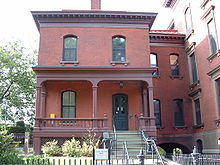
Corliss Brackett House, Brown's Admissions Office
Brown has recently adopted a financial aid policy which eliminates loans for all students whose family incomes are under $100,000. Furthermore, Brown has also eliminated all parental contributions for families whose incomes fall under $60,000. The program allocates approximately $70 million toward financial aid.
Brown seeks diverse applicants from "all walks of life, backgrounds, interests, and cultural heritages" but has "no quotas of any kind".
Boldly Brown
Under President Ruth Simmons, the University has launched a Campaign for Academic Enrichment. This campaign consists of re-evaluating the existing curriculum and raising $1.4 billion for greater academic ambition. The money will be used for academic programs, research, new facilities, biology and medicine, students who need financial assistance, and expanding the faculty and staff. In June 2009, it was announced that the campaign had met its goal nineteen months ahead of target, with record levels of giving despite the global economic crises of the fiscal year. The total sum raised currently stands at $1.415 billion.
Construction projects recently completed, in progress, and in preparation:
- Construction of the Sidney E. Frank Hall for Life Sciences (169,000 square feet, $95 million, completed autumn 2006)
- Relocation and renovation of Peter Green House, the history department (completed spring 2008)
- Conversion of Pembroke Hall, the original Pembroke College classroom building, to house the Cogut Center for the Humanities and the Pembroke Center for Teaching and Research on Women (completed autumn 2008)
- Conversion of J. Walter Wilson laboratories to house the Student Resources Building, with campus post office and University offices (completed autumn 2008)
- Conversion of Rhode Island Hall to house the Artemis A.W. and Martha Sharp Joukowsky Institute for Archaeology and the Ancient World (completed September 2009)
- Construction of The Walk through five city blocks from Lincoln Field to the Pembroke Campus (completion of Phase 5 after 2011, date contingent on removal of Ashamu Dance Studio and the greenhouse)
- Conversion of Faunce House to house the Stephen Robert '62 Campus Center (completion August 2010)
- Construction of the Perry and Marty Granoff Center for the Creative Arts (35,000 square feet, $40 million, completion December 2010)
- Conversion of the Metcalf laboratories on Thayer Street to the Mind Brain Behavior Building (74,000 square feet, $42 million, completion autumn 2011)
- Construction of the Aquatics and Fitness Center on Hope Street (72,000 square feet, $40 million, completion autumn 2011)
- Conversion of an art deco building on Richmond Street in the Jewelry District to the Medical Education Building of the Alpert Medical School ($45 million, completion autumn 2011)
校园
Brown is the largest institutional landowner in Providence, with properties in the East Side and the Jewelry District. Unlike some other schools, there are also no clear physical landmarks to determine where Brown's campus begins or ends.
There is no official designation of different campus areas from the University, but the institution's buildings can be roughly categorized as follows.
Main campus
Brown's main campus is located atop College Hill, in the East Side, across the Providence River from downtown Providence. This is the where the University was relocated in 1770 after it was first established in Warren, Rhode Island, in 1764. The main campus consists of 235 buildings and covers 143 acres (0.58 km). A salient feature of Brown's campus is that many of the academic departments reside in smaller, Victorian-era houses that the University has acquired over the years from the surrounding neighborhood.
The main campus area can be subdivided further into the inner, traditional campus greens and the outer neighborhood. The two greens, the Main Green and Lincoln Field, are large grass fields perpendicular to each other. These two areas contain many of the larger and more traditional academic and dormitory buildings, including University Hall (1770). This part of the main campus is enclosed by brick and rod iron fence, with the Van Wickle Gates serving as the prominent entrance on College Street. It is this area that is featured in most publications and photographs of Brown's campus.
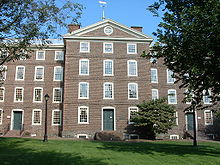
Built in 1770, University Hall is the oldest building on Brown's campus.
Outside of the gates, but still considered part of the main campus, are other University buildings and libraries that have been built at Brown over the centuries. This includes the Wriston Quad to the south of the Main Green; the John Hay Library and John D. Rockefeller, Jr. Library directly across the street from the Van Wickle Gates; and the Sciences Library and Thomas J. Watson, Sr. Center for Information Technology (CIT) adjacent to the Soldiers Memorial Gate. Because this area is not confined by the gates, Brown has been able to acquire larger plots of land and construct much larger buildings as the University has expanded.
Adjacent to Brown's main campus, and further down the Hill to the west by the Providence River, is the campus of the Rhode Island School of Design. Thayer Street, which runs through Brown's campus, is a commercial district that hosts many restaurants and shops popular with students and faculty from Brown and RISD.
Pembroke 校园
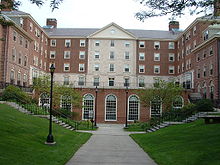
Andrews Hall on the Pembroke Campus
When Pembroke College (Brown University) merged with Brown in 1971, the campus was absorbed as part of Brown's overall campus. For the most part, the campus is made up of dormitories, although notable exceptions include Alumnae Hall, which houses a dance floor and a small University run diner known as the Gate, Smith-Buonano hall, host to many classrooms and Pembroke Hall, the original classroom building for Pembroke College and now the home of the Cogut Center for the Humanities and the Pembroke Center for Teaching and Research on Women. Furthermore, the campus has its own dining hall, Verney-Woolley Dining Hall, the second of Brown's main dining halls. Somewhere between 25 and 30% of the incoming Freshman class lives on Pembroke, though there are also many upperclassmen. The Brown Walk connects Pembroke Campus to the main campus.
East 校园
The East Campus was originally the main campus location of Brown's former neighbor Bryant College. Brown purchased Bryant's East Side campus in 1969 for $5.0 million when the latter school was moving to a new location. This added 10 acres (40,000 m) of land and additional 26 buildings adjacent to the main campus area. The area was officially designated East Campus in 1971.
Other areas
Also on the Hill, but further to the south and away from the main campus area, is Wickenden Street, another commercial district offering restaurants and shops. Brown Stadium, built in 1925 and home to the football team, is located approximately a mile to the northeast of the main campus. More recently, Brown has expanded into the Jewelry District, located in southern downtown Providence, by acquiring and renovating five buildings to serve as administrative and research facilities. Outside of Providence, Brown also owns a 376-acre (1.52 km) property, the Mount Hope Grant, in Bristol, which is the setting of the Haffenreffer Museum of Anthropology.
John Hay Library
Main article: John Hay Library
The John Hay Library is the second oldest library on campus. It was named for John Hay (Class of 1858), the private secretary and assistant to Abraham Lincoln, at the request of Andrew Carnegie, who contributed half of the $300,000 cost of the building. Constructed with Vermont white marble in an English Renaissance style, the library was dedicated on November 10, 1910 and had an estimated collection of 300,000 volumes. It is now the repository of Brown University archives, rare books and manuscripts, and special collections. Noteworthy among the latter are the Anne S.K. Brown Military Collection (described as "the foremost American collection of material devoted to the history and iconography of soldiers and soldiering"), the Harris Collection of American Poetry and Plays (described as "the largest and most comprehensive collection of its kind in any research library"), the Lownes Collection of the History of Science (described as "one of the three most important private collections of books of science in America"), and (for popularity of requests) the papers of H.P. Lovecraft. The Hay Library is home to one of the broadest collections of incunabula (15th-century printed books) in the Americas, as well as such rarities as the manuscript of Orwell's 1984 and a Shakespeare First Folio. There are also three books bound in human skin.
The Pembroke Center for Teaching and Research on Women manages the Elizabeth Weed Feminist Theory Papers and the Christine Dunlap Farnham Archives, both rich resources for feminist scholars.
John Carter Brown Library
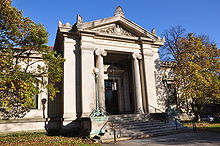
The John Carter Brown Library
Main article: John Carter Brown Library
The John Carter Brown Library, founded in 1846, is administered separately from the University, but has been located on the Main Green of the campus since 1904. It is generally regarded as the world's leading collection of primary historical sources pertaining to the Americas before 1825. It houses a very large percentage of the titles published before that date about the discovery, settlement, history, and natural history of the New World. The "JCB," as it is known, publishes Bibliotheca Americana, the main bibliography in the field. Typical of its noteworthy holdings is the best preserved of the seven surviving copies of Bay Psalm Book, the first extant book printed in British North America. There is also a very fine Shakespeare First Folio, added to the collection by John Carter Brown's widow (a Shakespeare enthusiast) on the grounds that it includes The Tempest, a play set in the New World. The JCB holdings comprise more than 50,000 early titles and about 16,000 modern books, as well as prints, manuscripts, maps, and other items in the library's specialty. The JCB occupies a Beaux-Arts style building designed by Shepley, Rutan, and Coolidge. The 1904 edifice was expanded in 1990 by architects Hartman-Cox of Washington, D.C.
Sustainability
Brown University has committed to “minimize its energy use, reduce negative environmental impacts and promote environmental stewardship.” The Energy and Environmental Advisory Committee has developed a set of ambitious goals for the university to reduce its carbon emissions and eventually achieve carbon neutrality. The Brown is Green website collects information about Brown’s progress toward greenhouse gas emissions reductions and related campus initiatives like courses, research, projects and student groups. Brown received an A- on the 2009 College Sustainability Report Card, developed by the Sustainable Endowments Institute. Brown was one of only 15 schools to receive a grade above a B+. There were no schools in the report that received an "A".
Student life
Atmosphere
Brown University has recently been ranked #1 for America's Happiest College Students, according to the Princeton Review 2010 rankings. Brown was also named "the most fashionable school in the Ivy League" by the fashion trade journal Women's Wear Daily on the basis that students on campus seem to have the strongest sense of personal style.
Brown is home to an active on-campus nightlife. A wide array of parties take place on the weekends, most of them in dorms and off-campus houses.
体育运动
Main article: Brown Bears
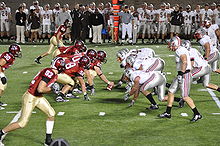
Brown v Harvard, September 2009
Brown is a member of the National Collegiate Athletic Association (NCAA) Division I Ivy League athletic conference. It sponsors 37 varsity intercollegiate teams. Its athletic programs have been featured in the College Sports Honor Roll as one of the top 20 athletic programs in the country according to U.S. News & World Report. Brown Women's Rowing Team has won 6 national titles in the last 12 years and Brown Football won the 2005 Ivy League Championships and shared the 1999 Ivy League title with Yale. The Football team more recently won a share of the 2008 title with Harvard. Brown's Men's Soccer program is consistently ranked in the top 25 and has won 18 Ivy League titles overall, including 8 of the last 12. Recent graduates play professionally in Major League Soccer and overseas. The Men's Lacrosse team also has a long and storied history, and more recently the program has again attained national rankings and exposure. In 2007, Brown won its first Ivy League baseball championship in school history. Brown's Varsity Equestrian team won the Ivy League Championships for the past two years in a row, and has consistently performed extremely well within the team's zone and region. Brown also features several competitive intercollegiate club sports, including its nationally ranked Sailing, Ultimate, and Women's Rugby teams. In 2005, the Men's Club Ultimate Frisbee team, Brownian Motion, won the National Championships.
[edit] Student organizations
See also: Category:Brown University organizations
There are over 300 registered student organizations on campus with diverse interests. The Student Activities Fair, during the orientation program, is an opportunity for first-years to become acquainted with the wide range of clubs.
Publications
- Brown Daily Herald
- College Hill Independent
- Critical Review
- Brown Journal of World Affairs
- Brown Policy Review
- The Brown Contemporary
- The Brown Noser
- The Brown Jug
- VISIONS
- Science and Society Review (affiliated with the Brown chapter of The Triple Helix)
Fine arts
- Brown University Band
- Brown University Orchestra
- Brown Opera Productions
- Production Workshop
Social Justice
- Space in Prisons for Arts and Creative Expression
- Students for a Democratic Society
- Students for Sensible Drug Policy
Others
- Brown Debating Union
- Brown Television
- WBRU
- Undergraduate Council of Students
- Undergraduate Finance Board
- Brown University Mock Trial
- BSR
- Brown Badmaash Dance Company
- The Jabberwocks of Brown University
- The Chattertocks of Brown University
- Graduate Student Council
- Starla and Sons
- Ivy Film Festival
- The Janus Forum
Residential and Greek Societies
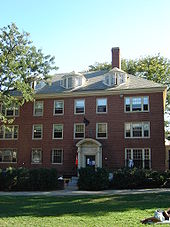
A fraternity house in Wriston Quadrangle
12.7% of Brown students are in fraternities or sororities. There are eleven residential Greek houses: six all-male fraternities (Alpha Epsilon Pi, Delta Tau, Delta Phi, Theta Delta Chi, Sigma Chi, and Phi Kappa Psi), two sororities (Alpha Chi Omega and Kappa Alpha Theta), one co-ed fraternity (Zeta Delta Xi), and two co-ed literary societies ( Alpha Delta Phi and St. Anthony Hall). All recognized Greek letter organizations live on-campus in University-owned dorm housing. Ten of the houses are overseen by the Greek Council and are located on Wriston Quadrangle. St. Anthony Hall, a co-ed fraternity that does not participate in Greek Council, is located in King House.
An alternative to fraternity life at Brown are the program houses, which are organized around various themes. As with Greek houses, the existing residents of each house take applications from students, usually at the start of the Spring semester. Examples of program houses include: Buxton International House, the Machado French/Hispanic House, Art House, Technology House, Harambee (African culture) House, Culinary Arts (Cooking) House and Interfaith House.
Currently, there are three student cooperative houses at Brown. Two of the houses, Watermyn and Finlandia on Waterman Street, are owned by the Brown Association for Cooperative Housing (BACH), an independent non-profit corporation owned and operated by house members. Founded by students in 1970, BACH is the only student owned and managed co-op in the nation and is famous for its annual naked party.
The third co-op, West House, is located in a Brown-owned house on Brown Street. All three houses also run a vegetarian food co-op for residents and non-residents.
Secret societies
Secret societies at Brown originated as literary clubs in the mid-18th century, and primarily existed to organize debates among their members. One early literary club was the Pronouncing Society, which disbanded in the mid-1770s. Another was Athenian at Queen's, founded in 1776 but also dissolved shortly afterwards. The Philermenian Society (founded as the Misokosmian Society) arose in 1794. In reaction to the Federalist Philermenians, a Democratic-Republican club called the United Brothers Society organized in 1806. In 1824 a third group, the Franklin Society, was formally recognized by the university president, and counted as honorary members Thomas Jefferson, John Quincy Adams, and Henry Clay. However, by the Civil War, most of these organizations had dissipated on account of newer Greek letter fraternities. There remains some dispute over the presence of these groups today, and at least one student organization claims descent from early secret societies. The Undergraduate Council of Students, Brown's student government, also reflects this historical legacy. The UCS originated as the Cammarian Club in 1893, a semi-secret senior society that served as an intermediary between the student body and the administration, and which ritualistically "tapped" fifteen new men each year until its dissolution after World War Two.
Traditions
Main article: Brown University traditions
Though the early history of Brown as a men's school includes a number of unusual hazing traditions, the University's present-day traditions tend to be non-violent while maintaining the spirit of zaniness.
Van Wickle Gates

Front view of the Van Wickle Gates
Main article: Van Wickle Gates
The Van Wickle Gates, dedicated on June 18, 1901, have a pair of center gates and a smaller gate on each side. The side gates remain open throughout the year, while the center gates remain closed except for two occasions each year. At the beginning of the academic year, the center gates open inward to admit students during Convocation. At the end of the second semester, the gates open outward for the Commencement Day procession. A traditional superstition is that students who pass through the gates for a second time before graduation do not graduate. The Brown Band famously flouts this tradition by marching in the yearly commencement procession. Undergraduate members, however, walk through the gates backwards, thereby avoiding the hex.
Josiah S. Carberry
Main article: Josiah S. Carberry
One of Brown's most notable traditions is keeping alive the spirit and accomplishments of Josiah S. Carberry, the fictional Professor of Psychoceramics (the equally fictional study of cracked pots), who was born on a University Hall billboard in 1929. He is the namesake of "Josiah's", a University-run snackbar. "Josiah" is also the name of the University's electronic library catalog.
According to Martha Mitchell's Encyclopedia Brunoniana, "On Friday, May 13, 1955, an anonymous gift of $101.01 was received by the University from Professor Carberry to establish the Josiah S. Carberry Fund in memory of his 'future late wife.' A condition of the gift was that, henceforth, every Friday the 13th would be designated 'Carberry Day,' and on that day friends of the University would deposit their loose change in brown jugs to augment the fund, which is used to purchase 'such books as Professor Carberry might or might not approve of.'" Students have followed this tradition ever since, and the fund currently has over $10,000 in it.
Mitchell writes, "Professor Carberry has been the subject of articles in a number of periodicals, including The New York Times, which proclaimed him 'The World's Greatest Traveler' on the front page of its Sunday travel section in 1974, and in Yankee magazine, where he was 'The Absent-Bodied Professor' in 1975. A recent honor which came to Professor Carberry was the award to him of an Ig Nobel Prize at the First Annual Ig Nobel Prize Ceremony in 1991. At this event sponsored by M.I.T. and the Journal of Irreproducible Results, Carberry, the 1991 Ig Nobel Interdisciplinary Research Prize laureate, was cited as 'bold explorer and eclectic seeker of knowledge, for his pioneering work in the field of psychoceramics, the study of cracked pots.'"
Spring Weekend
Main article: Spring Weekend
Starting in 1950, Brown replaced the traditional Junior Week and Junior Prom, which were discontinued during World War II, with Spring Weekend, which featured athletic contests and dances. Concerts featuring invited performers began in 1960, including Bob Dylan, U2, Bruce Springsteen, Janis Joplin, and James Brown.
Alma Mater
Main article: Brown University Alma Mater
The "Alma Mater" was written by James Andrews DeWolf (Class of 1861) in 1860, who named it "Old Brown" and set it to the tune of "Araby's Daughter" (which was later known as "The Old Oaken Bucket"). The song was renamed "Alma Mater", after the incipit, in 1869. It is sung and played after varsity athletic victories and at formal events such as Convocation and Commencement.
Computing projects
Several projects of note involving hypertext and other forms of electronic text have been developed at Brown, including:
- FRESS
- Brown University Interactive Language (BRUIN)
- Hypertext Editing System
- Women Writers Project
In addition, the Computer Science department at Brown is home to The CAVE. This project is a complete virtual reality room, one of few in the world, and is used for everything from three-dimensional drawing classes to tours of the circulatory system for medical students.
In 2000, a group of students from the university's Technology House converted the south side of the Sciences Library into a giant video display which allowed bystanders to play Tetris, the largest of its kind ever in the Western Hemisphere. Constructed from eleven custom-built circuit boards, a twelve-story data network, a personal computer running Linux, a radio-frequency video game controller, and over 10,000 Christmas lights, the project was named La Bastille and could be seen for several miles.
In April 2009, two of the university's graduate students defaced pages on wikis across the Internet running WikiMedia software, as part of their "Graffiti Project," to demonstrate a proof-of-concept of a file-sharing network that works by transmitting its data through third-party sites such as wikis. The students made a partial clean-up of the wiki sites that they targeted, but were unable to delete pages that they had added. The students were reprimanded, and the Chair of the university's Computer Science department apologized to the owners of the wikis that had been defaced.
知名校友与教职
Main article: List of Brown University people
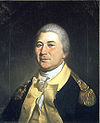
General James Mitchell Varnum, Class of 1769, painted posthumously in 1804 by Charles Willson Peale
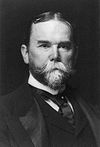
John Hay attended Brown University from 1855-1858. Brown's John Hay Library is named after him.
Brown University's alumni include numerous U.S. congressmen, senators, governors, prominent academics, authors, journalists, activists, businessmen, actors, and royalty. Some of its most prominent alumni include Chief Justice of the United States Charles Evans Hughes(1881), John D. Rockefeller Jr.(1897), Secretary of State John Hay(1852), John Hope(1894), first African-American president of Morehouse College and co-founder of the Niagara Movement, which became the National Association for the Advancement of Colored People (NAACP), CEO of IBM Thomas J. Watson, Jr. '37, media mogul and founder of CNN Ted Turner '60, co-founder of McKinsey & Co. and founder of modern management consulting Marvin Bower '25, John F. Kennedy, Jr. '83, diplomat Richard Holbrooke '62, Governor of Delaware Jack Markell '82, Governor of Louisiana Bobby Jindal '91, Governor of Rhode Island Donald Carcieri '65, President of Dartmouth College Jim Yong Kim '82, CEO of Bank of America Brian Moynihan, '81, sportscaster Chris Berman '77, actor John Krasinski '01, actress Laura Linney '86, singer Lisa Loeb '90, football coach Joe Paterno '50, film directors Todd Haynes '85 and Doug Liman '88, composer Duncan Sheik '92, and inspirational professor Randy Pausch '82.
Notable faculty have included former Prime Minister of Italy Romano Prodi, former President of Brazil Fernando Cardoso, economist William Poole, novelist and poet Chinua Achebe, Nobel laureate Leon Cooper, former President of Chile Ricardo Lagos, writer Carlos Fuentes, biologist Kenneth R. Miller, political scientist James Morone, Fields Medalist David Mumford, computer scientist Andries van Dam, and historian Gordon S. Wood.
[edit] 更多
- List of Brown University buildings
- List of Brown University statues
- Alpert Medical School
- Watson Institute for International Studies
- Brown Stadium
- Ladd Observatory
- Sarah Doyle Center
参考文献
- ^ Brown University Admission Facts and Figures, Brown University website. Retrieved 28 December 2009.
- ^ "Endowment Market Value and Percent Change". http://www.nacubo.org/Documents/research/2009_NCSE_Public_Tables_Endowment_Market_Values.pdf.
- ^ "Facts about Brown University: Faculty and Employees". Brown University. 2008-11-01. http://www.brown.edu/web/about/facts/faculty-employees. Retrieved 2009-07-09.
- ^ "Facts about Brown University". Brown University. http://www.brown.edu/web/about/facts/enrollment. Retrieved 2009-07-09.
- ^ "Encyclopedia Brunoniana | Bicentennial celebration". Brown University. http://www.brown.edu/Administration/News_Bureau/Databases/Encyclopedia/search.php?serial=B0180. Retrieved 2009-07-09.
- ^ "Get to Know Us: Our History". Brown University Admission Office. http://www.brown.edu/Administration/Admission/gettoknowus/ourhistory.html.
- ^ Mitchell, Martha. (1993). "Bear." Encyclopedia Brunoniana
- ^ "Baptist Identity and Christian Higher Education" (PDF). Baptist Identity and Christian Higher Education. Baylor University. http://www.baylor.edu/baylorpress/excerpt/105-excerpt.pdf. Retrieved 2010-04-30.
- ^ Brunson, Walter C. (1972). The History of Brown University, 1764-1914. p. 500.
- ^ "Providence." Encyclopedia Britannica. 1911. 11th edition. Vol 22 (POL-RHE). p. 511c: (Makeup of board, 22 Baptists, etc. No religious tests for admission. "Considered extraordinary liberal.")
- ^ Howell, Ricardo (2001, July). "Slavery, the Brown Family of Providence and Brown University" , Brown University News Service
- ^ "Brown to Commemorate 225th Anniversary of the March to Yorktown". Brown University Office of Media Relations. 2006-05-30. http://www.brown.edu/Administration/News_Bureau/2005-06/05-137.html.
- ^ "History of Brown". About Brown. Brown University. http://www.brown.edu/web/about/history. Retrieved 2007-12-05.
- ^ "Draft of a working paper for education at Brown University by Ira Magaziner with Elliot Maxwell and others". Brown University Library. http://library.brown.edu/record=b2103786. Retrieved 2007-12-06.
- ^ Leubsdorf, Ben (2005-03-02). "The New Curriculum Then". Brown Daily Herald. http://media.www.browndailyherald.com/media/storage/paper472/news/2005/03/02/Focus/The-New.Curriculum.Then-882258.shtml. Retrieved 2007-12-05.
- ^ Mitchell, Martha (1993). "Curriculum". Encyclopedia Brunoniana. Providence, RI: Brown University Library. ASIN B0006P9F3C. http://www.brown.edu/Administration/News_Bureau/Databases/Encyclopedia/search.php?serial=C0780. Retrieved 2007-12-06.
- ^ "RISD Grad Book 06-07" (PDF). Rhode Island School of Design. http://intranet.risd.edu/pdfs/GradHandbook0607.pdf. Retrieved 2007-12-05.
- ^ "about safeRIDE". safeRide for Brown + RISD. Brown University. http://www.brown.edu/saferide/. Retrieved 2007-12-05.
- ^ Brown University (2007-07-24). "Brown and RISD Announce Dual Degree Program". Press release. http://www.brown.edu/Administration/News_Bureau/2007-08/07-013.html. Retrieved 2007-12-06.
- ^ "Grade Inflation and the Brown Grading System: 2001-2002 Sheridan Center Research Project". The Teaching Exchange. Sheridan Center for Teaching, Brown University. http://www.brown.edu/Administration/Sheridan_Center/pubs/teachingExchange/jan2002/grade_inflat.shtml. Retrieved 2007-12-05.
- ^ Magaziner, Ira; Elliot Maxwell (2006-03-15). "Two Brown alums and architects of the New Curriculum express their skepticism toward plus/minus grading". Brown Daily Herald. http://media.www.browndailyherald.com/media/storage/paper472/news/2006/03/15/Columns/Ira-Magaziner.69.And.Elliot.Maxwell.68.Plusminus.System.Lacks.Educational.Value-1686938.shtml. Retrieved 2007-12-05.
- ^ Lutts, Chloe (2006-03-15). "Plus/minus fails key test: Faculty could still vote to change grading system". Brown Daily Herald. http://media.www.browndailyherald.com/media/storage/paper472/news/2006/03/15/CampusNews/Plusminus.Fails.Key.Test-1686967.shtml. Retrieved 2005-12-11.
- ^ "Plan for Academic Enrichment Status Report May 2007" (PDF). Brown University Office of the President. May 2007. http://www.brown.edu/web/pae/documents/PAEStatusReportMay2007_000.pdf. Retrieved 2007-12-05.
- ^ "Taskforce on Undergraduate Education". Brown University Office of the Provost. http://www.brown.edu/Administration/Provost/committees/tue/. Retrieved 2007-12-05.
- ^ "Steering Committee on Slavery and Justice". Brown University Steering Committee on Slavery and Justice. Brown University. http://www.brown.edu/Research/Slavery_Justice/. Retrieved 2007-12-05.
- ^ Zernike, Kate (2001-08-01). "Slave Traders in Yale's Past Fuel Debate on Restitution". nytimes.com/. http://www.nytimes.com/2001/08/13/nyregion/13YALE.html?pagewanted=all&pagewanted=print. Retrieved 2010-04-17.
- ^ "Slavery and Justice: Report of the Brown University Steering Committee on Slavery and Justice" (PDF). Brown University Steering Committee on Slavery and Justice. Brown University. http://www.brown.edu/Research/Slavery_Justice/documents/SlaveryAndJustice.pdf. Retrieved 2007-12-05.
- ^ A Forgotten History: The Slave Trade and Slavery in New England
- ^ "Parliament and the British Slave Trade 1600-1807". Slavetrade.parliament.uk. http://slavetrade.parliament.uk/slavetrade/index.html. Retrieved 2009-07-09.
- ^ St. John's College (2007-02-06). "Cambridge schools commemorate slave trade abolition". Press release. http://www.joh.cam.ac.uk/news/pg/article==142. Retrieved 2007-12-05.
- ^ "History - Slavery and the Building of Britain". BBC. 2007-02-02. http://www.bbc.co.uk/history/british/abolition/building_britain_gallery_06.shtml. Retrieved 2009-07-09.
- ^ Simmons, Ruth. (2006-02-16) (MP3). Hidden in Plain Sight: Slavery and Justice in Rhode Island. [Lecture]. St. John's College. http://www.joh.cam.ac.uk/chapel_and_choir/bicentenary_2007. Retrieved 2007-12-05.
- ^ "Repository of Historical Documents". Brown University Steering Committee on Slavery and Justice. Brown University. http://dl.lib.brown.edu/slaveryandjustice/. Retrieved 2007-12-05.
- ^ Brown University (February 2007) (PDF). Response of Brown University to the Report of the Steering Committee on Slavery and Justice. Brown University. http://brown.edu/Research/Slavery_Justice/documents/SJ_response_to_the_report.pdf. Retrieved 2007-12-05.
- ^ Brown University (2007-02-24). "Brown Announces Commitments to Providence Public Schools". Press release. http://www.brown.edu/Administration/News_Bureau/2006-07/06-107.html. Retrieved 2007-12-05.
- ^ Pinofold, John (July 2006). "We are all brethren". Oxford Today: The University Magazine (Oxford University). http://www.oxfordtoday.ox.ac.uk/2006-07/v19n2/01.shtml. Retrieved 2007-12-05.
- ^ Liss, Emmy (2007-11-27). "Brown loves Ruth: Approval rating for Simmons sky-high". Brown Daily Herald. http://media.www.browndailyherald.com/media/storage/paper472/news/2007/11/27/CampusNews/Brown.Loves.Ruth.Approval.Rating.For.Simmons.SkyHigh-3116895.shtml. Retrieved 2007-12-05.
- ^ Undergraduate Concentrations Completed: Selected Years
- ^ History of the Brown Medical School
- ^ "Best Medical Schools - Graduate Schools - Education - US News and World Report". Grad-schools.usnews.rankingsandreviews.com. http://grad-schools.usnews.rankingsandreviews.com/grad/med. Retrieved 2009-07-09.
- ^ Shanghai Jiao Tong University (2009). "Academic Ranking of World Universities". Institute of Higher Education, Shanghai Jiao Tong University. http://www.arwu.org/ARWU2009.jsp. Retrieved 2009-12-23.
- ^ Shanghai Jiao Tong University (2009). "Ranking of North & Latin American Universities". Institute of Higher Education, Shanghai Jiao Tong University. http://www.arwu.org/Americas2009.jsp. Retrieved 2009-12-23.
- ^ "America's Best Colleges". Forbes. 2009. http://www.forbes.com/lists/2009/94/colleges-09_Americas-Best-Colleges_Rank.html. Retrieved 2009-09-13.
- ^ The Times (2009). "World University Rankings". The Times Higher Educational Supplement. http://www.topuniversities.com/university-rankings/world-university-rankings/2009/results. Retrieved 2010-02-09.
- ^ "National Universities Rankings". America's Best Colleges 2009. U.S. News & World Report. 2009. http://colleges.usnews.rankingsandreviews.com/college/national-search. Retrieved 2009-05-18.
- ^ "The Washington Monthly National University Rankings" (PDF). The Washington Monthly. 2009. http://www.washingtonmonthly.com/college_guide/rankings/national_university_rank.php. Retrieved 2009-12-23.
- ^ "A Focus on Undergrads" and "Best National Universities," U.S. News & World Report: America's Best Colleges: 2010 Edition, pp. 15, 88-9.
- ^ How to Choose a College - Forbes.com
- ^ "Top U.S. Producers of Fulbright Students, by Type of Institutions, 2009-10 - International - The Chronicle of Higher Education". Chronicle.com. 2009-10-19. http://chronicle.com/article/Top-US-Producers-of/48847/. Retrieved 2010-02-22.
- ^ "SSRN-A Revealed Preference Ranking of U.S. Colleges and Universities by Christopher Avery, Mark Glickman, Caroline Hoxby, Andrew Metrick". Papers.ssrn.com. http://papers.ssrn.com/sol3/papers.cfm?abstract_id=601105. Retrieved 2010-02-22.
- ^ Brown University Office of Admission facts and figures
- ^ "Facts about Brown University: Undergraduate Admission". Brown.edu. http://www.brown.edu/web/about/facts/admission. Retrieved 2010-02-22.
- ^ "August 2008 Update from the Dean". Brown University Graduate School. 2009-03-31. http://gradschool.brown.edu/update.php?id=1217563200.
- ^ "Brown admits 10.8% in most selective year ever". Brown Daily Herald. 2006-04-04. http://media.www.browndailyherald.com/media/storage/paper472/news/2009/03/31/CampusNews/Brown.Admits.10.8.In.Most.Selective.Year.Ever-3689313.shtml?sourcedomain=www.browndailyherald.com&MIIHost=media.collegepublisher.com.
- ^ Ivy Success article
- ^ Hernandez College Consulting
- ^ Brown Ends Tuition for Lower-Income 学生 The New York Times February 25, 2008 . Retrieved February 25, 2008.
- ^ Brown Q&A 10/2009
- ^ Boldly Brown web site
- ^ "Despite downturn, Brown builds on | Education | projo.com | The Providence Journal". projo.com. 2009-12-30. http://www.projo.com/education/content/BUILDING_BROWN_12-27-09_RQGRJ67_v38.3619ce1.html. Retrieved 2010-02-22.
- ^ "Building Brown: Peter Green House". Brown.edu. http://www.brown.edu/Facilities/Building_Brown/projects/petergreen/. Retrieved 2010-02-22.
- ^ "Building Brown: Pembroke Hall". Brown.edu. http://www.brown.edu/Facilities/Building_Brown/projects/pembroke/. Retrieved 2010-02-22.
- ^ "Building Brown: J.W. Wilson Student Resource Building". Brown.edu. http://www.brown.edu/Facilities/Building_Brown/projects/jww/. Retrieved 2010-02-22.
- ^ "Building Brown: The Artemis A.W. and Martha Sharp Joukowsky Institute for Archaeology and the Ancient World". Brown.edu. http://www.brown.edu/Facilities/Building_Brown/projects/rihall/. Retrieved 2010-02-22.
- ^ "Building Brown: The Walk". Brown.edu. http://www.brown.edu/Facilities/Building_Brown/projects/walk/. Retrieved 2010-02-22.
- ^ "Building Brown: Stephen Robert '62 Campus Center at Faunce House". Brown.edu. http://www.brown.edu/Facilities/Building_Brown/projects/srobertcntr/. Retrieved 2010-02-22.
- ^ "Building Brown: Perry and Marty Granoff Center for the Creative Arts". Brown.edu. http://www.brown.edu/Facilities/Building_Brown/projects/creativearts/. Retrieved 2010-02-22.
- ^ "Building Brown: The Mind Brain Behavior Building". Brown.edu. http://www.brown.edu/Facilities/Building_Brown/projects/mindbrain/. Retrieved 2010-02-22.
- ^ "Building Brown: Aquatics and Fitness Center". Brown.edu. http://www.brown.edu/Facilities/Building_Brown/projects/aquatics/. Retrieved 2010-02-22.
- ^ "Building Brown: Medical Education Building". Brown.edu. http://www.brown.edu/Facilities/Building_Brown/projects/meded/. Retrieved 2010-02-22.
- ^ R.M. Kliment & Frances Halsband Architects (January 2004). "Analysis". Strategic Framework for Physical Planning Brown University. Brown University. http://www.brown.edu/webmaster/strategic_framework/framework/kh.swf. Retrieved 2007-12-21.
- ^ "Brown Houses". Brown University. http://www.brown.edu/Facilities/Facilities_Management/docs/Brown%20Houses_11x17.jpg. Retrieved 2007-12-21.
- ^ From Martha Mitchell's Encyclopedia Brunoniana: John Hay Library
- ^ Drake, Miriam (2003). Encyclopedia of Library and Information Science. CRC Press. ISBN 0824720776. http://books.google.com/books?id=tPnkxsklgXoC&dq=john+hay+library+librarians. Retrieved 2008-04-01.
- ^ "The Anne S. K. Brown Military Collection :: Brown University Library". Dl.lib.brown.edu. http://dl.lib.brown.edu/libweb/collections/askb/. Retrieved 2010-02-22.
- ^ Johnson, M.L. (2006, January 7). "Some of nation's best libraries have books bound in human skin." Associated Press
- ^ "Department of Facilities Management, Energy and Environmental Advisory Committee". Brown University. http://www.brown.edu/Facilities/Facilities_Management/energy_policy_recommendations.php. Retrieved 2008-05-28.
- ^ "information on Brown’s efforts to create a more sustainable environment". Brown University. http://www.brown.edu/Departments/Brown_Is_Green/. Retrieved 2008-05-28.
- ^ "College Sustainability Report Card 2009". Sustainable Endowments Institute. http://www.endowmentinstitute.org/. Retrieved 2008-10-28.
- ^ "Top 10 Colleges with the Happiest Students - MSN Encarta". Archived from the original on 2009-10-31. http://www.webcitation.org/5kwQQEjvD.
- ^ Perkins, Sara. (2004, April 19). "Fashion Journal likes what Brown is wearing." The Brown Daily Herald
- ^ U.S. News & World Report. (2002, March 18). "College Sports: Honor Roll." U.S. News & World Report
- ^ "Brown GSC". Brown.edu. http://www.brown.edu/Students/GSC/. Retrieved 2010-02-22.
- ^ Aviv, Rachel (2007-01-07). "Black Tie Optional". The New York Times. http://www.nytimes.com/2007/01/07/education/edlife/07nakedparties.html. Retrieved 2010-04-27.
- ^ Cochrane Bronson, Walter (1972). The History of Brown University, 1764-1914. p. 500.
- ^ Meacham, Scott (1999). "Halls, Tombs and Houses: Student Society Architecture at Dartmouth". Dartmo.: The Buildings of Dartmouth College. http://www.dartmo.com/halls/hallscontent2.html. Retrieved 2007-12-06.
- ^ Mitchell, Martha (1993). "Philermenian Society". Encyclopedia Brunoniana. Providence, RI: Brown University Library. ASIN B0006P9F3C. http://www.brown.edu/Administration/News_Bureau/Databases/Encyclopedia/search.php?serial=P0190. Retrieved 2007-12-06.
- ^ Mitchell, Martha (1993). "United Brothers Society". Encyclopedia Brunoniana. Providence, RI: Brown University Library. ASIN B0006P9F3C. http://www.brown.edu/Administration/News_Bureau/Databases/Encyclopedia/search.php?serial=U0010. Retrieved 2007-12-06.
- ^ Mitchell, Martha (1993). "Franklin Society". Encyclopedia Brunoniana. Providence, RI: Brown University Library. ASIN B0006P9F3C. http://www.brown.edu/Administration/News_Bureau/Databases/Encyclopedia/search.php?serial=F0260. Retrieved 2007-12-06.
- ^ Mitchell, Martha (1993). "Fraternities". Encyclopedia Brunoniana. Providence, RI: Brown University Library. ASIN B0006P9F3C. http://www.brown.edu/Administration/News_Bureau/Databases/Encyclopedia/search.php?serial=F0270. Retrieved 2007-12-06.
- ^ "Societas Domi Pacificae 1824". Pacifica House. http://www.pacificahouse.org/. Retrieved 2010-02-22.
- ^ "Post- » Brown A-Z". Post.browndailyherald.com. 2009-09-04. http://post.browndailyherald.com/2009/09/04/brown-a-z/. Retrieved 2010-02-22.
- ^ Mitchell, Martha (1993). "Cammarian Club". Encyclopedia Brunoniana. Providence, RI: Brown University Library. ASIN B0006P9F3C. http://www.brown.edu/Administration/News_Bureau/Databases/Encyclopedia/search.php?serial=C0050. Retrieved 2009-6-08.
- ^ Poulson, Dan. (March 1, 2002). "Investigating the death of campus traditions." The Brown Daily Herald
- ^ Mitchell, Martha. (1993). "Van Wickle Gates." Encyclopedia Brunoniana
- ^ Mitchell, Martha. (1993). "Carberry, Josiah S.." Encyclopedia Brunoniana
- ^ "Brown Admission: Brown Traditions". http://www.brown.edu/Administration/Admission/gettoknowus/browntraditions.html.
- ^ Mitchell, Martha. (1993). "Spring Weekend." Encyclopedia Brunoniana
- ^ Brown Concert Agency
- ^ Mitchell, Martha. (1993). "Alma Mater." Encyclopedia Brunoniana
- ^ La Bastille: A Tech House Art Installation
- ^ "Play Tetris On A Building Wall…And Steve Wozniak Will Visit You". The Mac Observer. 2000-04-25. http://www.macobserver.com/news/00/april/000425/wozontetris.shtml.
- ^ Spam Attack Reversed, RichmondWiki Blog. Retrieved April 13, 2009.
- ^ (See page source for URL) Graffiti Networks: a subversive, internet-scale file sharing model. Retrieved April 13, 2009.
- ^ 2010 Kaplan / Newsweek College Guide
External links
 |
Wikimedia Commons has media related to: Brown University |
 |
University portal |
 |
Rhode Island portal |
- Brown University
- Official Brown athletics site
Coordinates: 41°49′34″N 71°24′12″W / 41.826167°N 71.403250°W / 41.826167; -71.403250



